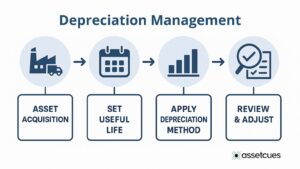Introduction: The Cost of “Ghost Assets”
Imagine discovering that 10–30% of the fixed assets on your company’s books are fiction. These “ghost assets” inflate book values and skew financial statements, leading to overstated assets, overpaid taxes or insurance, and compliance risks. Eliminating ghost assets isn’t just cleanup – it protects the bottom line and ensures audit compliance.
Discover How Finance & Audit Leaders Can Master the Entire Asset Lifecycle
Proper fixed asset life cycle management is critical to prevent such losses. It means overseeing an asset’s journey from acquisition and capitalization, through its useful life (with depreciation and maintenance), until final disposal. Done right, it keeps financial records accurate and audit-ready by bridging day-to-day asset management with sound accounting and compliance practices at every stage.
What Is the Fixed Asset Life Cycle? (Definition & Key Stages)
The fixed asset life cycle is the sequence of stages an asset goes through from acquisition to final disposal. It typically includes four key phases:
- Acquisition & Capitalization: Purchasing or creating the asset and recording it on the books as a capital asset (instead of expensing it immediately).
- Useful Life & Depreciation: Using the asset over its productive life and allocating its cost to expense through periodic depreciation.
- Maintenance & Tracking: Keeping the asset in working condition with regular upkeep and tracking its location and status.
- Disposal (Retirement): Removing the asset from service and from the financial records via sale, scrapping, or donation.
Each phase comes with specific tasks and controls to keep asset records accurate. The next sections detail how to manage each stage effectively while staying in compliance with standards.
Explore key stages and process of the asset lifecycle >>
Asset Acquisition and Capitalization – Laying the Foundation
At acquisition, organizations decide whether to capitalize a purchase or expense it. A clear capitalization policy ensures larger purchases with future benefit become fixed assets, while smaller ones are expensed. For instance, a $50,000 machine is capitalized and depreciated, whereas $500 supplies are expensed. Capturing key details and tagging new assets immediately ensures consistent records and prevents gaps from day one.
Establish strong internal controls for asset additions with management approval and supporting documents. This creates an audit trail and ensures compliance with laws like SOX requiring strict financial controls. Since executives must certify statements, misreported assets risk serious penalties. Enforcing disciplined procedures at acquisition builds a reliable foundation for the asset’s lifecycle.
Depreciation and Useful Life – Managing Value Over Time
Once an asset is on the books, you need to manage its value as it ages. Depreciation allocates an asset’s cost over its useful life. Setting a realistic useful life at acquisition is critical, since it determines the depreciation expense each period. For example, a vehicle might be estimated at 5 years, while a piece of machinery might be 10 years.
Next, choose a depreciation method and apply it consistently. Many companies use straight-line depreciation for simplicity and consistency. Others might use accelerated methods for certain assets or for tax purposes, but the key is to follow accounting standards and use the method uniformly. Inconsistent or aggressive depreciation will draw auditor scrutiny.

Depreciation is not a set-and-forget process, as circumstances often change. An asset may wear out faster than expected or become obsolete earlier. Therefore, reviewing asset lives and adjusting depreciation prevents sudden write-offs and financial surprises. Regular reviews ensure accurate statements and demonstrate to auditors that asset values are reliable.
Asset Tracking & Maintenance – Ensuring Audit-Ready Records
Tracking each asset’s existence and condition is essential for reliable records. Without vigilance, ghost assets accumulate, distorting financials and inflating tax or insurance costs. Each missing asset increases risk and wastes organizational resources unnecessarily. Regularly reconciling the fixed asset register ensures every listed item physically exists.
Conduct regular asset audits to verify actual inventory against recorded assets. Perform a full physical inventory yearly and spot checks for high-value or mobile equipment. During audits, scan each tag and match results with system records, investigating discrepancies immediately. These controls meet auditor expectations and help detect potential problems early.
Use technology to streamline tracking by assigning unique tags and managing assets in a centralized system. Update records whenever an asset is moved, serviced, or disposed to keep financial and operational data aligned. Maintain an audit trail of lifecycle events with dates and responsible persons. This ensures quick access to history for auditors and supports compliance with regulations like SOX.

Have Questions About Asset Tracking?
With 10+ years of hands-on experience, our team offers practical, industry-specific advice.

Have Questions About Asset Tracking?
With 10+ years of hands-on experience, our team offers practical, industry-specific advice.
Compliance and Standards – ISO 55000 & SOX Requirements
Fixed asset management isn’t just an internal concern – it must also meet external standards and regulations. Two major frameworks are ISO 55000 and the Sarbanes-Oxley Act (SOX). ISO 55000 provides an international framework for systematic asset management throughout the life cycle, emphasizing a complete asset register, clear policies, risk management, and continuous improvement.
Aligning with ISO 55000 assures stakeholders that assets are managed in a structured and reliable way. At the same time, SOX requires strict internal controls for accurate financial reporting. For fixed assets, this includes documented procedures, approvals, and regular reconciliations for additions, disposals, and depreciation. Since executives must certify financials, weak asset control risks restatements or severe penalties.
Modern Fixed Asset Life Cycle Management Solutions (SaaS Tools)
Managing assets manually with spreadsheets and paper is cumbersome and error-prone. However, modern fixed asset management software automates and streamlines the entire lifecycle, ensuring greater accuracy. Therefore, many organizations adopt these tools to improve control, enhance efficiency, and strengthen compliance.
Key features to look for include:
-
Centralized System:
A single database for all asset information ensures everyone (finance, operations, auditors) works from the same up-to-date data. Ideally, the system integrates with your financial ledger so asset additions, disposals, and depreciation entries automatically flow into the books without manual input.
-
Audit Trails & Reporting:
A robust platform logs every event in an asset’s lifecycle and generates audit-ready reports. Moreover, each change—acquisition, transfer, maintenance, revaluation, or disposal—is timestamped to create an instant audit trail. As a result, reports like asset registers, depreciation schedules, or disposal lists are produced quickly, eliminating tedious spreadsheet work during audits.

These tools provide clear benefits, including higher accuracy, fewer ghost assets, and faster audits. They automate tedious tasks like reconciliations and depreciation, freeing teams for higher-value analysis. With improved asset data, organizations make smarter budgeting and maintenance decisions. Ultimately, leveraging technology is vital for asset management cycle excellence and growing compliance demands.
Explore how to manage the full lifecycle of physical and equipment assets>>
FAQ: Fixed Asset Lifecycle Management
Q1: What software can track an asset through its lifecycle?
A: By using dedicated fixed asset management software with tags and a centralized database, you can track an asset from purchase through disposal. Moreover, such a system automatically logs each stage of an asset’s life—acquisition, depreciation, maintenance, and disposal—and generates audit-ready reports. As a result, you gain complete visibility and documentation without relying on spreadsheets.
Q2: Why is fixed asset lifecycle management important for finance and audit teams?
A: Because it ensures financial statements accurately reflect company assets, investor trust and compliance remain strong. Proper lifecycle management also prevents ghost assets or sudden write-offs through systematic tracking. In short, it protects the bottom line, strengthens internal controls, and enables faster audits.
Q3: What is the fixed asset life cycle?
A: The fixed asset life cycle spans from an asset’s acquisition to its final disposal. It includes acquisition, depreciation during use, required maintenance, and eventual disposal or sale. Understanding this helps Finance manage depreciation, IT plan upkeep, and Audit track assets throughout their useful life.
Q4: What are the 5 P’s of asset management?
A: The “5 P’s” of asset management are People, Processes, Performance, Policy, and Planning. Emphasizing these five pillars ensures skilled people and efficient processes, measured performance, clear policies, and proactive planning. This holistic focus aligns Finance’s budgeting and control, IT’s operational efficiency, and Audit’s compliance oversight in asset management.
Q5: What is Asset Lifecycle Management (ALM)?
A: Asset Lifecycle Management (ALM) is the holistic process of managing each phase of an asset’s life—from planning and acquisition to operation, maintenance, and disposal. It ensures assets are used cost-effectively, maintained properly, and retired responsibly, unifying Finance, IT, and Audit to maximize value, reduce risk, and maintain compliance.

Optimize Your Asset Lifecycle Management with AssetCues
From automated tracking to insightful analytics, see how AssetCues helps reduce costs and improve efficiency—request a demo or contact our team today.

Optimize Your Asset Lifecycle Management with AssetCues
From automated tracking to insightful analytics, see how AssetCues helps reduce costs and improve efficiency—request a demo or contact our team today.
Still Not Sure RFID or Barcode, Which One Is Right for You?
Our experts have over a decade of experience in asset tracking and can guide you further based on your requirements
Conclusion & Call-to-Action
In summary, effective fixed asset lifecycle management is a cross-functional effort with significant payoffs. By recording and capitalizing assets, monitoring depreciation with proper schedules, and conducting regular audits, organizations ensure long-term compliance and accuracy. Moreover, aligning practices with frameworks like ISO 55000 and SOX strengthens overall financial reporting standards.
This proactive approach reduces financial risk, preventing unexpected write-offs or negative audit findings. It also builds trust and confidence among executives, auditors, and key stakeholders that organizational asset data remains reliable and consistent.
A dedicated fixed asset management platform automates tracking and compliance, reducing spreadsheet hassles and saving time. With the right tools, organizations gain valuable insights, simplify audit-ready management, and transform fixed asset management into a strategic advantage.
About Author






